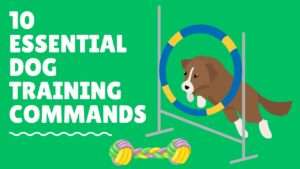Dogs are wonderful companions, but they don’t come pre-programmed to understand our human world. That’s where obedience training comes in.
Training your dog not only teaches them how to behave but also strengthens the bond between you and your furry friend.
In this comprehensive guide, we’ll delve into the world of obedience training, covering everything from the basics to advanced techniques, so you can unleash your dog’s full potential.
Contents Overview
Understanding Obedience Training
Obedience training is more than just teaching your dog to sit or stay on command.
It encompasses a wide range of behaviors that help your dog become a well-mannered member of your family and society.
From basic commands like sit, stay, and come, to more advanced skills like leash walking and socialization, obedience training sets the groundwork for a harmonious relationship between you and your canine companion.
Why Obedience Training Matters
Behavioral Management
Obedience training helps in curbing unwanted behaviors such as excessive barking, chewing, or jumping on people. It establishes boundaries and teaches dogs what is acceptable behavior.
Communication
Training facilitates clear communication between you and your dog. Through consistent commands and cues, dogs learn to understand what is expected of them, leading to better cooperation and mutual understanding.
Safety
A well-trained dog is safer in various situations. They are less likely to run into traffic, approach aggressive dogs, or ingest harmful substances. Basic commands like “come” or “stay” can prevent potentially dangerous situations.
Socialization
Training exposes dogs to different environments, people, and animals, promoting socialization skills. This helps them become more confident and well-adjusted in various social settings, reducing fear or aggression towards unfamiliar stimuli.
Bonding
Training sessions are not just about teaching commands; they are opportunities to strengthen the bond between you and your dog. Positive reinforcement techniques create a trusting and affectionate relationship based on respect and mutual appreciation.
Key Benefits of Obedience Training
Improved Behavior
Dogs learn to respond to commands promptly, leading to a well-behaved and obedient pet.
Enhanced Safety
Trained dogs are less likely to engage in risky behaviors that could endanger themselves or others.
Better Social Skills
Socialization during training helps dogs interact positively with people and other animals, reducing the likelihood of aggression or anxiety.
Stress Reduction
Knowing what is expected of them can alleviate anxiety in dogs, leading to a calmer demeanor overall.
Increased Freedom
With reliable obedience skills, dogs can enjoy more freedom during walks, off-leash activities, and outings with their owners.
Types of Obedience Training
1- Basic Obedience
Focuses on fundamental commands like sit, stay, come, and heel. It lays the groundwork for more advanced training.
2- Advanced Obedience
Builds upon basic commands and introduces more complex tasks such as off-leash control, agility, or obedience competitions.
3- Behavior Modification
Addresses specific behavioral issues such as aggression, separation anxiety, or fearfulness through specialized training techniques.
4- Therapy Dog Training
Prepares dogs to provide emotional support and assistance in various therapeutic settings, requiring advanced obedience skills and temperament assessments.
Getting Started with Obedience Training
1- Understanding Obedience Training
Obedience training is the process of teaching your dog to respond reliably to verbal cues and hand signals. It encompasses basic commands like sit, stay, come, down, heel, and more advanced behaviors as your dog progresses.
2- Start with Basic Commands
Begin with fundamental commands such as sit, stay, and come. These commands form the foundation of obedience training and are essential for managing your dog’s behavior in various situations.
3- Use Positive Reinforcement
Positive reinforcement is the most effective and humane method of training. Reward your dog with treats, praise, toys, or affection when they obey a command correctly. Positive reinforcement strengthens the desired behavior and encourages your dog to repeat it.
4- Consistency is Key
Consistency is crucial in obedience training. Use the same cues and hand signals consistently, and enforce rules consistently across all family members. Inconsistency can confuse your dog and impede their progress.
5- Practice Patience
Obedience training takes time and patience, especially for puppies and dogs with limited prior training. Be patient and understanding, and avoid getting frustrated if progress is slow. Celebrate small victories and remain consistent in your training efforts.
6- Set Realistic Goals
Set achievable goals based on your dog’s age, breed, and individual temperament. Break down training into manageable steps, gradually increasing difficulty as your dog masters each command.
7- Train in Various Environments
Practice obedience training in different environments to generalize your dog’s responses. Start training in a quiet, distraction-free area and gradually introduce distractions, such as other people, dogs, or environmental stimuli.
8- Use Leash and Collar Training
Leash and collar training teaches your dog to walk politely on a leash and respond to leash cues. Use gentle, consistent leash pressure to guide your dog’s movements and reinforce desired behaviors.
9- Address Problem Behaviors
Obedience training can also help address problem behaviors such as jumping, chewing, barking, and aggression. Identify the underlying causes of these behaviors and use obedience training to teach alternative, more desirable behaviors.
10- Seek Professional Guidance if Needed
If you encounter challenges or feel overwhelmed by obedience training, don’t hesitate to seek guidance from a professional dog trainer or behaviorist. They can provide personalized advice and support to address specific issues and accelerate your dog’s progress.
Bottom Line
Obedience training is a journey that strengthens the bond between you and your dog while instilling good manners and behaviors.
By understanding the principles of training, starting early, and being consistent and patient, you can unlock your dog’s full potential and enjoy a fulfilling relationship built on trust and respect.
So, unleash your dog’s potential today through the power of obedience training!

Meet Colleen Campbell, the dedicated Owner and Trainer of Positive Interactions Dog Behavior and Training, LLC. With over three decades of experience in research at Dow Chemical, Colleen brings a wealth of knowledge and a scientific approach to her dog training business.






























+ There are no comments
Add yours